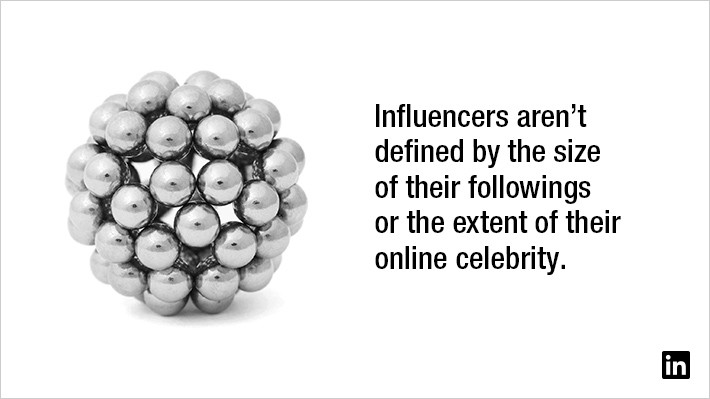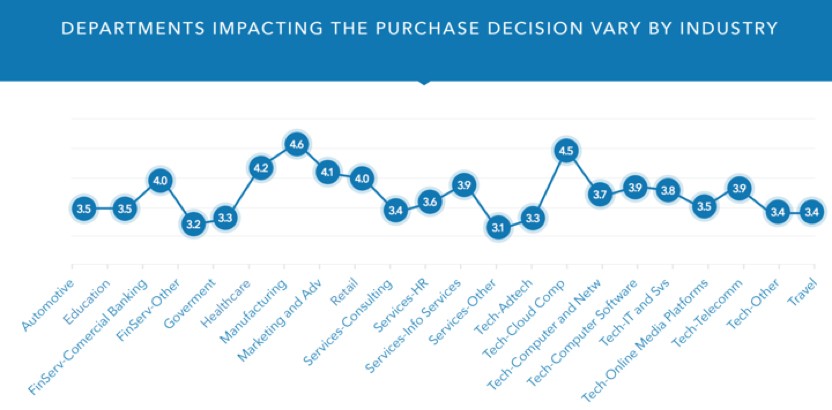What Are Influencers, and How Do They Affect the B2B Buyer's Journey?
In today’s B2B purchase cycle, influence comes from all directions.
As a seller, you can’t control every channel of influence in the buyer’s journey. But when you recognize and account for them, you will be in far better position.
Peers, practitioners, and colleagues, and more are all sources of pre-purchase guidance, education, and research. It makes perfect sense that the B2B buying process is a collaborative one for considered and significant purchases.
This post breaks down the various influencers and their impacts at different stages of the buying cycle. Understanding who holds influence, and the role they play in the purchase process, can help you proactively address this in your sales approach.
Widening Influence Inside the Buying Circle
Driven by decentralized organizational structures, individuals who influence major purchases internally are often distributed across divisions, functional areas and even geographic regions. For example, C-level executives, line-of-business owners and business managers all often play a role.
While multiple stakeholders sit on the average B2B buying committee, it’s helpful to define their parts in the overall process. The types of roles will vary depending on industry and size of the prospect’s company. That said, our research shows 3.1 to 4.6 groups inside a company – such as IT, finance, and HR – influence the average purchase process.
Consider a major technology purchase. The extended buying group in this case might include people from the following groups:
- Executives
- Business unit users (sometimes cross-functional)
- Business development
- Finance
- Engineering
- Operations
- IT
This extended sphere of influence features individuals with different needs and desired outcomes. While each might approach the potential purchase with different reasons in mind, they can all help sway the ultimate decision.
However, it is shortsighted to assume the internal influence stops there. In larger companies, members from the board of directors can influence strategic purchases. Moreover, decision makers might consult colleagues from different business units who’ve made similar purchases in the past.
It’s worth noting that millennials in a variety of roles are weighing in more and more on their companies’ purchases. According to Forrester, 73% of millennials in the workforce are involved in B2B purchasing decisions. In fact, one-third report they are the sole decision maker for their department.
Moreover, various research projects that millennials and Gen-Z will represent 75% of the workplace by 2025. LinkedIn surveyed 5,470 global professionals who had some role, whether budgeting, selecting, consulting, or implementing, in purchasing a particular technology. We found that as the buying committee continues to expand, most are evenly distributed between millennial and Gen X cohorts.
Sway from External Influences
In addition to working with colleagues inside their companies when making purchase decisions, B2B buyers consult their fellow peers and others — often on social media.
External influencers can include:
- Analysts
- Industry experts
- Thought leaders
- Media commentators
- Partners
- Consultants
- Customers
Consider these findings from Demand Gen Report’s 2018 B2B Buyers Survey illustrating the heightened influence of third-party sources and outside input on the path to purchase:
- 65% of buyers rely on peer recommendations and review sites
- 54% use social media to research vendors and solutions
- 36% ask thought leaders for their opinion
Influencer Impact at Each Stage of the Deal
It’s important to understand how various influencers affect your deal at different stages of the purchase process. While it is impossible to distill this to a one-size-fits-all mapping, we can make some useful generalizations.
An effective practice is to review the type of content buyers seek at each stage of the purchase journey and map these content types to the field of external influencers. After all, content is simply an information vehicle, just as influencers are an information source.
In the early stage, buyers usually seek out thought leadership and educational content. As such, they will consult external experts who can inform their understanding of top issues and trends during cursory research. These could include analysts, subject matter experts, and thought leaders. As a result, top-of-funnel prospects might come to the table with preconceived notions they gathered from one or more industry influencers.
Early-Stage Influence Takeaway: Become familiar with respected authorities in your niche and keep a bead on their content or social media updates to better understand viewpoints and perspectives that might be instilled in your prospects.
Prospects in the middle stage want to evaluate and narrow down their options. At this point, they consume more product-specific content along with case studies, comparisons, and evaluation guides. According to research by Influitive, nearly 90% of buyers are influenced by customer testimonials during the purchase decision.
When consulting internal influencers at this stage, prospects often call upon those can help evaluate both business and technical details, such as IT and engineering. For external perspectives, they might turn to respected peers, partners, and customers of the vendor under consideration.
Middle-Stage Influence Takeaway: Customer testimonials and peer reviews are key as buyers begin to narrow their options and gravitate toward a decision.
In the final stage of their journey, buyers need to validate their purchase decision. They vet their choice through content such as demos, total cost of ownership, and ROI calculators. It is common at this point to again enlist the input of peers, partners, and existing customers. Additionally, buyers will seek to generate consensus on the purchase committee, and throughout the organization. So, lower-funnel prospects might be influenced by operations colleagues, technology stakeholders, user-level team members, and the finance group.
Late-Stage Influence Takeaway: Expanding your own influence across the buying committee and in other relevant areas of the organization can help solidify consensus.
Position Yourself to Swing the Balance in Your Favor
In addition to decision makers, hidden influencers can hold sway in the ultimate purchase choice. They can impact whether a large deal is awarded to you or a competitor — or whether the status quo prevails. Failing to build strong ties to even one of these influencers could lead to the collapse of important deals.
The more connections you establish within and beyond a prospect’s company, and the more you interact with these people on social media, the more fully you’ll understand how various decision makers and influencers work together.
This approach empowers you to make the most of influence arriving from any direction.
For more information on the various influencers in B2B deals and how to extend your own influence, download our guide: Read Me If You Want to Build Valuable Relationships on LinkedIn.
Topics: LinkedIn sales guides Sales trends
Related articles





